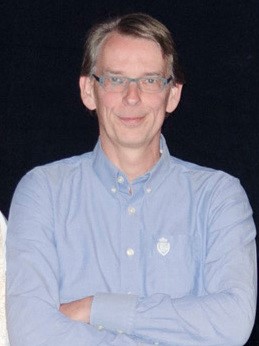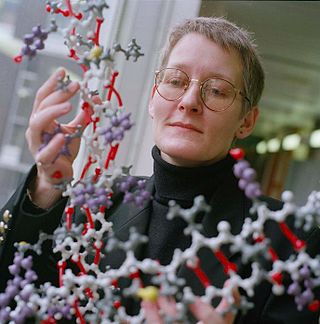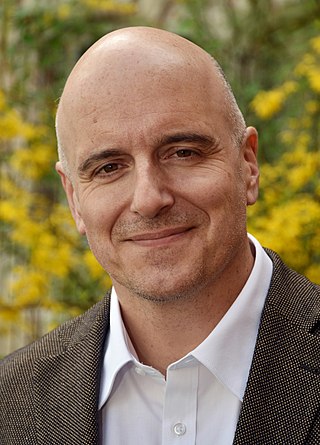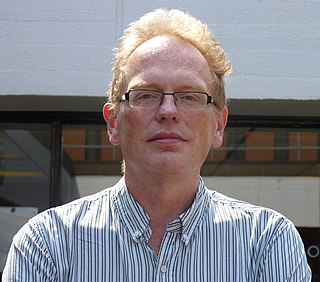Related Research Articles
Prolog is a logic programming language associated with artificial intelligence and computational linguistics.
In bioinformatics, BLAST is an algorithm and program for comparing primary biological sequence information, such as the amino-acid sequences of proteins or the nucleotides of DNA and/or RNA sequences. A BLAST search enables a researcher to compare a subject protein or nucleotide sequence with a library or database of sequences, and identify database sequences that resemble the query sequence above a certain threshold. For example, following the discovery of a previously unknown gene in the mouse, a scientist will typically perform a BLAST search of the human genome to see if humans carry a similar gene; BLAST will identify sequences in the human genome that resemble the mouse gene based on similarity of sequence.

BioPerl is a collection of Perl modules that facilitate the development of Perl scripts for bioinformatics applications. It has played an integral role in the Human Genome Project.
In cryptography, a private information retrieval (PIR) protocol is a protocol that allows a user to retrieve an item from a server in possession of a database without revealing which item is retrieved. PIR is a weaker version of 1-out-of-n oblivious transfer, where it is also required that the user should not get information about other database items.

The Smith–Waterman algorithm performs local sequence alignment; that is, for determining similar regions between two strings of nucleic acid sequences or protein sequences. Instead of looking at the entire sequence, the Smith–Waterman algorithm compares segments of all possible lengths and optimizes the similarity measure.
The Protein Information Resource (PIR), located at Georgetown University Medical Center, is an integrated public bioinformatics resource to support genomic and proteomic research, and scientific studies. It contains protein sequences databases
Patrick John Hayes FAAAI is a British computer scientist who lives and works in the United States. As of March 2006, he is a senior research scientist at the Institute for Human and Machine Cognition in Pensacola, Florida.

Amos Bairoch is a Swiss bioinformatician and Professor of Bioinformatics at the Department of Human Protein Sciences of the University of Geneva where he leads the CALIPHO group at the Swiss Institute of Bioinformatics (SIB) combining bioinformatics, curation, and experimental efforts to functionally characterize human proteins.

Carole Anne Goble, is a British academic who is Professor of Computer Science at the University of Manchester. She is principal investigator (PI) of the myGrid, BioCatalogue and myExperiment projects and co-leads the Information Management Group (IMG) with Norman Paton.

Apache Taverna was an open source software tool for designing and executing workflows, initially created by the myGrid project under the name Taverna Workbench, then a project under the Apache incubator. Taverna allowed users to integrate many different software components, including WSDL SOAP or REST Web services, such as those provided by the National Center for Biotechnology Information, the European Bioinformatics Institute, the DNA Databank of Japan (DDBJ), SoapLab, BioMOBY and EMBOSS. The set of available services was not finite and users could import new service descriptions into the Taverna Workbench.

Robert David Stevens is a professor of bio-health informatics. and former Head of Department of Computer Science at The University of Manchester
The BioCatalogue is a curated catalogue of Life Science Web Services. The BioCatalogue was launched in June 2009 at the Intelligent Systems for Molecular Biology Conference. The project is a collaboration between the myGrid project at the University of Manchester led by Carole Goble and the European Bioinformatics Institute led by Rodrigo Lopez. It is funded by the Biotechnology and Biological Sciences Research Council.
Dataspaces are an abstraction in data management that aim to overcome some of the problems encountered in data integration system. The aim is to reduce the effort required to set up a data integration system by relying on existing matching and mapping generation techniques, and to improve the system in "pay-as-you-go" fashion as it is used. Labor-intensive aspects of data integration are postponed until they are absolutely needed.
Edward Marcotte is a professor of biochemistry at The University of Texas at Austin, working in genetics, proteomics, and bioinformatics. Marcotte is an example of a computational biologist who also relies on experiments to validate bioinformatics-based predictions.

Rolf Apweiler is a director of European Bioinformatics Institute (EBI) part of the European Molecular Biology Laboratory (EMBL) with Ewan Birney.

Teresa K. Attwood is a professor of Bioinformatics in the Department of Computer Science and School of Biological Sciences at the University of Manchester and a visiting fellow at the European Bioinformatics Institute (EMBL-EBI). She held a Royal Society University Research Fellowship at University College London (UCL) from 1993 to 1999 and at the University of Manchester from 1999 to 2002.

Christoph Steinbeck is a German chemist and has a professorship for analytical chemistry, cheminformatics and chemometrics at the Friedrich-Schiller-Universität Jena in Thuringia.

Andrew M. Brass is a Professor of Bioinformatics at the University of Manchester in the Department of Computer Science and Faculty of Life Sciences.
Open PHACTS was a European initiative public–private partnership between academia, publishers, enterprises, pharmaceutical companies and other organisations working to enable better, cheaper and faster drug discovery. It has been funded by the Innovative Medicines Initiative, selected as part of three projects to "design methods for common standards and sharing of data for more efficient drug development and patient treatment in the future".
References
- 1 2 Paton, Norman W.; Díaz, Oscar (1999). "Active database systems" (PDF). ACM Computing Surveys . 31: 63–103. CiteSeerX 10.1.1.34.8207 . doi:10.1145/311531.311623. S2CID 207770770.
- ↑ Stevens, R.; Baker, P.; Bechhofer, S.; Ng, G.; Jacoby, A.; Paton, N. W.; Goble, C. A.; Brass, A. (2000). "TAMBIS: Transparent Access to Multiple Bioinformatics Information Sources". Bioinformatics. 16 (2): 184–185. doi: 10.1093/bioinformatics/16.2.184 . PMID 10842744.
- 1 2 Taylor, C. F.; Paton, N. W.; Lilley, K. S.; Binz, P. A.; Julian Jr, R. K.; Jones, A. R.; Zhu, W.; Apweiler, R.; Aebersold, R.; Deutsch, E. W.; Dunn, M. J.; Heck, A. J. R.; Leitner, A.; Macht, M.; Mann, M.; Martens, L.; Neubert, T. A.; Patterson, S. D.; Ping, P.; Seymour, S. L.; Souda, P.; Tsugita, A.; Vandekerckhove, J.; Vondriska, T. M.; Whitelegge, J. P.; Wilkins, M. R.; Xenarios, I.; Yates Jr, J. R.; Hermjakob, H. (2007). "The minimum information about a proteomics experiment (MIAPE)". Nature Biotechnology. 25 (8): 887–893. doi: 10.1038/nbt1329 . PMID 17687369.
- ↑ Pedrioli, P. G. A.; Eng, J. K.; Hubley, R.; Vogelzang, M.; Deutsch, E. W.; Raught, B.; Pratt, B.; Nilsson, E.; Angeletti, R. H.; Apweiler, R.; Cheung, K.; Costello, C. E.; Hermjakob, H.; Huang, S.; Julian, R. K.; Kapp, E.; McComb, M. E.; Oliver, S. G.; Omenn, G.; Paton, N. W.; Simpson, R.; Smith, R.; Taylor, C. F.; Zhu, W.; Aebersold, R. (2004). "A common open representation of mass spectrometry data and its application to proteomics research". Nature Biotechnology. 22 (11): 1459–1466. doi:10.1038/nbt1031. PMID 15529173. S2CID 25734712.
- 1 2 Norman Paton publications indexed by Google Scholar
- 1 2 Norman Paton at the Mathematics Genealogy Project
- ↑ Paton, N. W.; Gray, P.M.D. (1990). "Optimising and Executing DAPLEX Queries using Prolog". The Computer Journal . 33 (6): 547–555. doi: 10.1093/comjnl/33.6.547 .
- ↑ Norman Paton publications indexed by Microsoft Academic
- ↑ Norman W. Paton at DBLP Bibliography Server
- ↑ Norman Paton's publications indexed by the Scopus bibliographic database. (subscription required)
- ↑ Norman Paton author profile page at the ACM Digital Library
- ↑ Information Management Group at the University of Manchester
- ↑ Paton, Norman William (1989). A Prolog implementation of an object-oriented database system (PhD thesis). University of Aberdeen.
- ↑ Gray, P. M.; Moffat, D. S.; Paton, N. W. (1988). "A Prolog interface to a Functional Data Model database". Advances in Database Technology—EDBT '88. Lecture Notes in Computer Science. Vol. 303. p. 34. doi:10.1007/3-540-19074-0_46. ISBN 978-3-540-19074-5.
- ↑ Paton, N. W.; Gray, P. M. D. (1988). "Identification of database objects by key". Advances in Object-Oriented Database Systems. Lecture Notes in Computer Science. Vol. 334. p. 280. doi:10.1007/3-540-50345-5_25. ISBN 978-3-540-50345-3.
- ↑ Guo, Chenjuan (2011). Inferring Information about Correspondencies between Data sources for Dataspaces (PhD thesis). University of Manchester.
- ↑ Belhajjame, K.; Paton, N. W.; Embury, S. M.; Fernandes, A. A. A.; Hedeler, C. (2013). "Incrementally improving dataspaces based on user feedback". Information Systems . 38 (5): 656. CiteSeerX 10.1.1.303.1957 . doi:10.1016/j.is.2013.01.006.
- ↑ Belhajjame, K.; Paton, N. W.; Embury, S. M.; Fernandes, A. A. A.; Hedeler, C. (2010). "Feedback-based annotation, selection and refinement of schema mappings for dataspaces" (PDF). Proceedings of the 13th International Conference on Extending Database Technology - EDBT '10. p. 573. CiteSeerX 10.1.1.298.3519 . doi:10.1145/1739041.1739110. ISBN 9781605589459.
- ↑ Galpin, I.; Brenninkmeijer, C. Y. A.; Gray, A. J. G.; Jabeen, F.; Fernandes, A. A. A.; Paton, N. W. (2010). "SNEE: A query processor for wireless sensor networks" (PDF). Distributed and Parallel Databases. 29 (1–2): 31–85. CiteSeerX 10.1.1.220.9109 . doi:10.1007/s10619-010-7074-3. S2CID 45589.
- ↑ Galpin, I.; Taylor, R.; Gray, A. J. G.; Brenninkmeijer, C. Y. A.; Fernandes, A. A. A.; Paton, N. W. (2011). "Executing In-network Queries Using SNEE". Advances in Databases. Lecture Notes in Computer Science. Vol. 7051. p. 136. doi:10.1007/978-3-642-24577-0_15. ISBN 978-3-642-24576-3.
- ↑ Swainston, N.; Smallbone, K.; Mendes, P.; Kell, D.; Paton, N. (2011). "The SuBliMinaL Toolbox: Automating steps in the reconstruction of metabolic networks". Journal of Integrative Bioinformatics. 8 (2): 186. doi: 10.1515/jib-2011-186 . PMID 22095399.
- ↑ Castrillo, J. I.; Zeef, L. A.; Hoyle, D. C.; Zhang, N.; Hayes, A.; Gardner, D. C.; Cornell, M. J.; Petty, J.; Hakes, L.; Wardleworth, L.; Rash, B.; Brown, M.; Dunn, W. B.; Broadhurst, D.; O'Donoghue, K.; Hester, S. S.; Dunkley, T. P.; Hart, S. R.; Swainston, N.; Li, P.; Gaskell, S. J.; Paton, N. W.; Lilley, K. S.; Kell, D. B.; Oliver, S. G. (2007). "Growth control of the eukaryote cell: A systems biology study in yeast". Journal of Biology. 6 (2): 4. doi:10.1186/jbiol54. PMC 2373899 . PMID 17439666.
- ↑ Grants awarded to Norman Paton by the EPSRC
- 1 2 Grants awarded to Norman Paton by the BBSRC
- ↑ Antonioletti, M.; Atkinson, M.; Baxter, R.; Borley, A.; Chue Hong, N. P.; Collins, B.; Hardman, N.; Hume, A. C.; Knox, A.; Jackson, M.; Krause, A.; Laws, S.; Magowan, J.; Paton, N. W.; Pearson, D.; Sugden, T.; Watson, P.; Westhead, M. (2005). "The design and implementation of Grid database services in OGSA-DAI". Concurrency and Computation: Practice and Experience. 17 (2–4): 357. doi:10.1002/cpe.939. S2CID 911042.
- ↑ "News from Head of School". 16 June 2008. Archived from the original on 3 October 2019.
- ↑ "News from Head of School". 21 February 2011. Archived from the original on 3 October 2019.